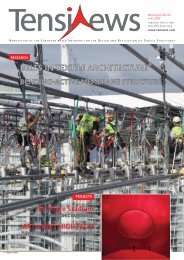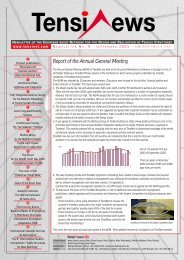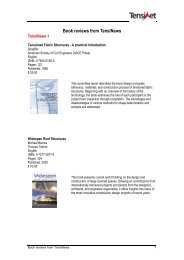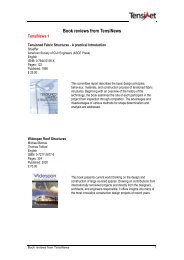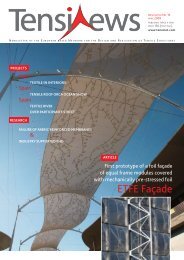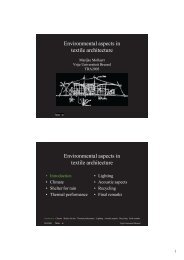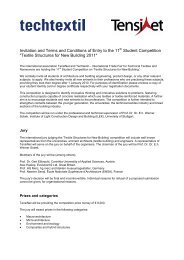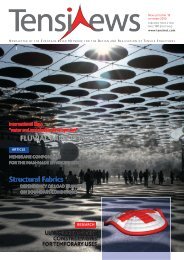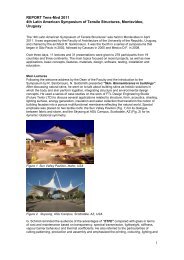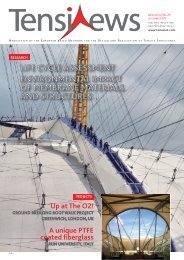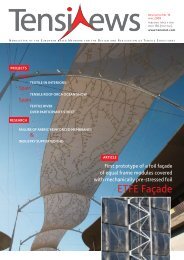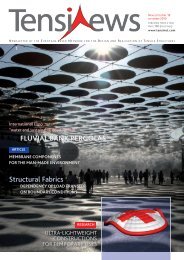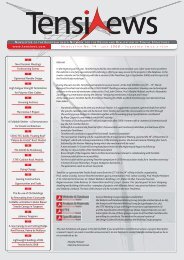Tensinews 21 - sept2011 - vers 31-8 - TensiNet
Tensinews 21 - sept2011 - vers 31-8 - TensiNet
Tensinews 21 - sept2011 - vers 31-8 - TensiNet
Create successful ePaper yourself
Turn your PDF publications into a flip-book with our unique Google optimized e-Paper software.
REPORT<br />
20 TENSINEWS NR. <strong>21</strong> – SEPTEMBER 2011<br />
4 th Latin American Symposium Uruguay<br />
Tensile Structures Montevideo 2011<br />
The “4 th Latin American Symposium of Tensile Structures” was held in<br />
Montevideo in April 2011. It was organized by the Faculty of Architecture<br />
of the Uni<strong>vers</strong>ity of the Republic, Uruguay, and chaired by the architect R.<br />
Santomauro. It was the fourth in a series of symposiums that began in São<br />
Paulo in 2002, followed by Caracas in 2005 and Mexico D.F. in 2008.<br />
Main Lectures<br />
Following the welcome address by the Dean of<br />
the Faculty and the introduction to the Symposium<br />
by R. Santomauro, N. Goldsmith presented<br />
“Skin. Biomembranes in buildings”.<br />
After discussing natural skins, he went on to<br />
talk about building skins as holistic solutions in<br />
which the body and skin perform together, integrating<br />
structure and environmental design<br />
concepts. He used a series of case studies on<br />
the work of FTL Design Engineering Studio (Future<br />
Tents LTD) to discuss several applications<br />
related to structure, form, acoustics, shading,<br />
lighting surface, energy generation, insulation<br />
and water collection that transform the notion<br />
of building facades into a porous multifunctional<br />
membrane reflecting the natural world.<br />
Special emphasis was placed on two textile<br />
roofs: the Sun Valley Pavilion (Fig. 1) for its<br />
dialogue between fabric and stone, and the<br />
Skysong at ASU Campus, Scottsdale, AZ (Fig. 2)<br />
for its dynamic rotational symmetry.<br />
G. Schmid reminded the audience of the advantages<br />
of “ETFE” compared with glass in terms of<br />
1<br />
cost and maintenance based on transparency,<br />
spectral transmission, lightweight, stiffness,<br />
vapour barrier behaviour and thermal coefficients.<br />
He also referred to the particularities of<br />
cutting patterning, production and assembly<br />
and emphasized the printing, colouring, lighting<br />
and self-cleaning capabilities together with<br />
recent applications in many fields that allow<br />
forward-looking architects to design their<br />
self-marketing envelopes (Fig. 3).<br />
The most frequently mentioned realization,<br />
with two main lectures and two presentations,<br />
was "La Plata Stadium" in Argentina (G. Castro,<br />
R. Ferreira, F. García Zúñiga, H. Larrotonda,<br />
M. Levy and T. Birdair), a derivative of the<br />
tensegrity Georgia Dome. Several speakers<br />
outlined the construction engineering, planning<br />
and procedures for the roof assembly, detailing<br />
the cable net lifting, jacking system and<br />
membrane installation (Fig. 4).<br />
In “Ejemplos en y desde Uruguay. Metodología<br />
de trabajo”, P. Pinto and R. Santomauro presented<br />
the Uruguayan state of the art with a<br />
wealth of examples and a detailed description<br />
of the entire process, from a simple primary<br />
Over three days, 11 lectures and <strong>31</strong> presentations were given to<br />
278 participants from 19 countries and three continents.<br />
The main topics focused on recent projects, as well as new applications,<br />
basic concepts, features, materials, design, software, testing,<br />
installation and education.<br />
2<br />
5 6 7<br />
idea to the exact definition of the project, including<br />
all of the structural elements and their<br />
details, the membrane, its patterns and its installation<br />
on site (Fig. 5).<br />
In “Lightweight structures and membranes for<br />
stadiums”, K. Stockhunsen from SBP insisted on<br />
the design and installation of roofs for largespan<br />
applications. Worldwide developments in<br />
recent decades culminate in the designs of the<br />
sports venues for the World Cup 2010 in South<br />
Africa and the future icons of the Brazilian<br />
World Cup in 2014. Other impressive realizations<br />
were presented from the Berlin Olympic<br />
Stadium 2010 to the Warsaw National Stadium<br />
2012 and Rio de Janeiro Maracana Stadium<br />
2014 (Fig. 6).<br />
C. Bauer from Mehler Tex•nologies began his<br />
presentation “Tensile architecture. Principles of<br />
feasibility, sustainability and reliability in the<br />
practice” with the Vitruvius principles (durability,<br />
utility and beauty) and summarized a<br />
chronological development and possible future<br />
evolutions. He described several aspects of<br />
tensile architecture as advantageous and<br />
3




